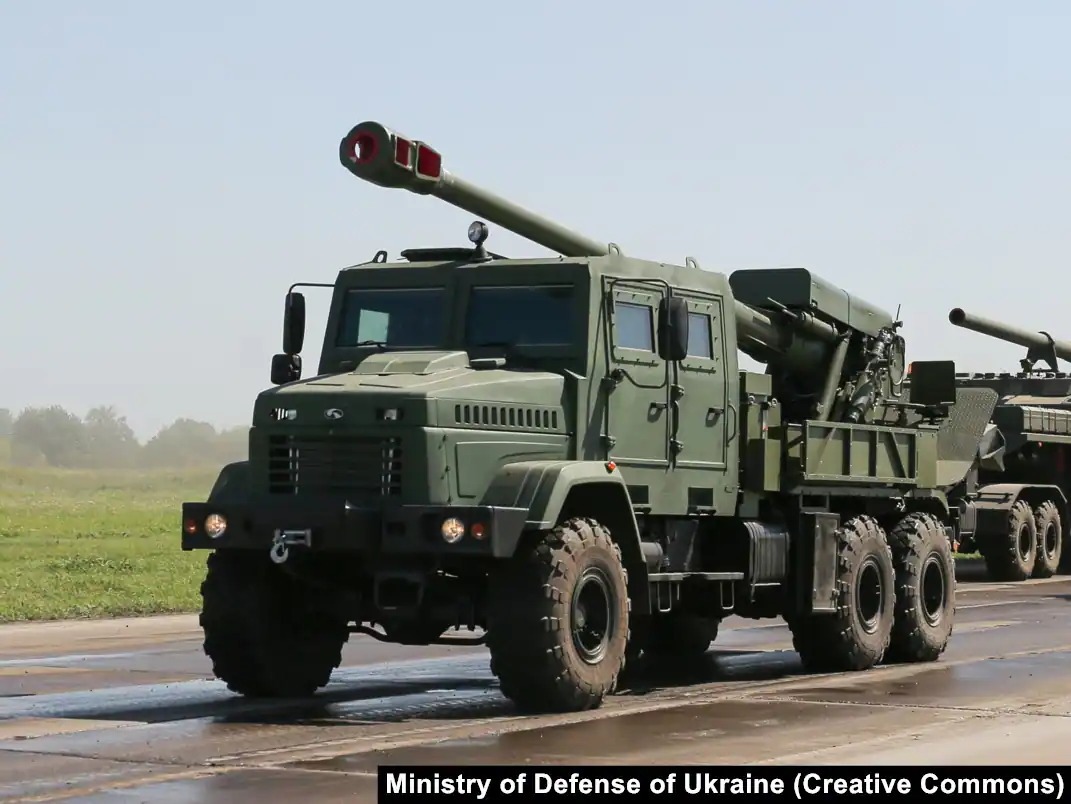Ukraine has managed to attain steady production of the 2S22 Bohdana self-propelled gun (SPG) when Russia nearly destroyed all of its indigenous defense industry in line with the “demilitarization” goal of its Special Military Operation (SMO).
The gun is Ukraine’s first domestically-produced 155-mm artillery system. The first extensive capital weapons system coming out of Ukrainian arms factories is significant since Kyiv is now nearly entirely dependent on Western arms supplies.
This ranges from small arms, rifle and pistol ammunition, to big platforms, including surface-to-air missiles (SAM), tanks, towed and self-propelled artillery, reconnaissance drones, and minor naval vessels like patrol boats and minesweepers.
Interestingly, reports from Ukraine also note the struggle to fully domesticate production and break away from the prevailing Soviet-styled and Russia-linked industrial, defense industrial model and production of spare parts, components, ancillary industries, and supply chains.
Developing Gun Amid Destroyed Industry & War
Latest Ukrainian reports celebrated how its industry has managed to churn out 30 units, where not a single one has been lost in battle. The Public Joint Stock Company (PJSC) Kramatorsk Heavy Duty Machine Tool Building Plant developed the gun. First unveiled in 2018, upgraded versions began reaching Ukrainian units in September.
Quoting unnamed officials in the Ukrainian Army, Defense Express said PJSC Kramatorsk is producing it at an “impressive rate of six howitzers per month.” Some of these units also sport an automatic loading mechanism, which Ukrainian soldiers had long awaited as a significant personnel-friendly feature. On November 29, the 1st Special Purpose Brigade posted a picture of a Bohdana unit, which Defense Express claimed was an “automatic rammer.”

If the production number of 72 units a year is maintained, Ukraine will match the production rate of the French Caesar truck-mounted SPG. Increasing this rate from the first two to six units “took more than one and a half years.”
Russian Strikes On Battlefield & Defense Industry
But what represents the defense industrial problems under the threat of Russian missile strikes are the connected industries supplying components, assemblies, and sub-assemblies. “25 companies and 400 specialists” manufacture the gun, while some critical parts are made abroad. “Some production steps are scattered across the country to avoid Russian long-range strikes,” Defense Express said.
The Russian Ministry of Defense (RuMoD) often publicizes “long-range missile strikes” by “military aviation forces” on “warehouses and production facilities” of the Armed Forces of Ukraine (AFU). The “demilitarization” goal of the SMO is driven by the thinking that Ukraine should “cease” to be a “threat” to the breakaway Lugansk and Donetsk People’s Republic (LDPR) and the Russian Federation if it joins NATO.
Other reports from Ukrainian media suggest Kyiv is gearing up to scale up the production of the 155-mm artillery rounds and the gun system itself. “This is especially important in the context of the overall artillery shortage in Western countries, prompting Kyiv to wait for months before new guns arrive from the partners,” Defense Express added.
Ukraine is yet to receive all of the 400 self-propelled and 250 towed howitzers at a time when some have been destroyed in combat. “There’s also the service life issue because guns get worn out very quickly in such an intense counter-battery warfare.”
Technical, Administrative, Industrial, Bureaucratic, & Commercial Obstacles
However, the development of the Bohdana itself met several bureaucratic and technical hurdles after the project began in 2015. The first was deciding whether the gun should fire 152-mm caliber shells as per Soviet practices or NATO-standard 155-mm rounds.
Technical hindrances consisted of developing metallurgical and alloy technologies for the barrel to withstand the heavy rates of fire. Producing it requires sophisticated industrial procedures of surgical precision metal shaping and cutting.
The SPG must also withstand heavy use as a complete system besides individual components. The chassis should tolerate 28 tons of load, the shot’s recoil, while the armor must protect electronic systems from mines and shrapnel, apart from wear and tear in transport and possibly live small arms fire.
In a twist of fate, by August 2022, the German PzH 2000 SPGs began breaking down in Ukraine for the same reasons, as AFU was firing several hundred rounds a day. The German manufacturer stipulated far more than 100 rounds as “high-intensity” warfare.
Moreover, the political decision to settle for the type of caliber (152 mm) overlapped with another industrial, commercial, and military aspect, where many rounds would be required for live-fire training. “The Ministry of Defense and the KZVV argued over who should import 155-mm shells, hundreds of which were needed for testing. Why Ukraine has not established their production is a separate question,” Pravda said.
Economic hurdles were next. Developing “own artillery” is a “risky multi-million dollar investment” requiring “years” of testing since the possibly costly development phase alone will deter the state or the military from buying it. Ironically, the US and European defense industries face the same struggle, unable to arm Ukraine in time and replenish their armories following donations to Kyiv.
This is because of years of underinvestment in high production capacities. The countries mainly fought unconventional wars with non-state actors, not geared toward conflicts with militarily advanced peer actors. Ukraine, a developing country, serendipitously faced the same situation four years before the war.
When The Ukrainian Military Destroyed The Gun
But the most controversial moment was in the immediate aftermath of the Russian attack in February 2022, when the Ukrainian General Staff ordered the destruction of the gun to prevent Russia from capturing it, another report on Ukrainska Pravda said.
The first final configuration prototype was ready by the fall of 2019 and “passed initial tests.” However, subsequent tests were not commenced by early 2022, and the “first (and only) Bohdana was standing in a hangar” in Kramatorsk.
“At the beginning of the Russian invasion, the Ukrainian General Staff made a decision to destroy all weapons and promising developments that cannot be used and that could potentially fall into the hands of the enemy,” the report claimed.
Latest Hurdle: Choices Of Carrier Truck
The choice of the truck for mounting the 155-mm gun is the first test of this obstacle. Ukraine has also been looking for European military truck makers, apart from the domestic AvtoKrAZ (or the Kremenchuk Automobile Plant KrAZ), to diversify suppliers and not overburden stressed production lines.

Some production batches of the gun are mounted on trucks made by Czech truck maker Tatra. Tatra, however, takes one year to manufacture a single T815 armored vehicle. This has led Ukraine to choose to “consider alternatives.” Ukraine cannot afford to “(not) assemble guns quickly and consistently and (keep) complaining about foreign contractors” and meet its immediate war needs.
Nevertheless, The administration is looking at the German company MAN, a leading manufacturer of military vehicles, notably the HX series of trucks, a joint venture (JV) between MAN and Rheinmetall.
Other options are to “resuscitate” the domestic KrAZ company or “develop a towed version of the Bohdana,” which the developers are “already working on.” KrAZ had declared bankruptcy in 2021, long before Russia attacked Ukraine.
Ukraine Needs Artillery
The primarily land war has seen artillery superiority deciding the outcome of nearly the entire frontline. Russia has a stable defense industry supplying howitzers of various calibers.
On the contrary, Ukraine has very little of its Soviet-era D-20 and D-30 towed field guns or the 122-mm Gvozdika SPG remaining. It is presently solely depending on Western systems like the M777 light-weight gun, M109 Paladin (US), France’s 155-mm 52 calibers Caesar SPG; the Polish 155-mm AHS KRAB SPG, and Germany’s Panzerhaubitze (PzH) 2000 SPG. Early in November, it deployed the Swedish-origin Archer truck-mounted SPG.
- The author can be reached at satamp@gmail.com
- Follow EurAsian Times on Google News




